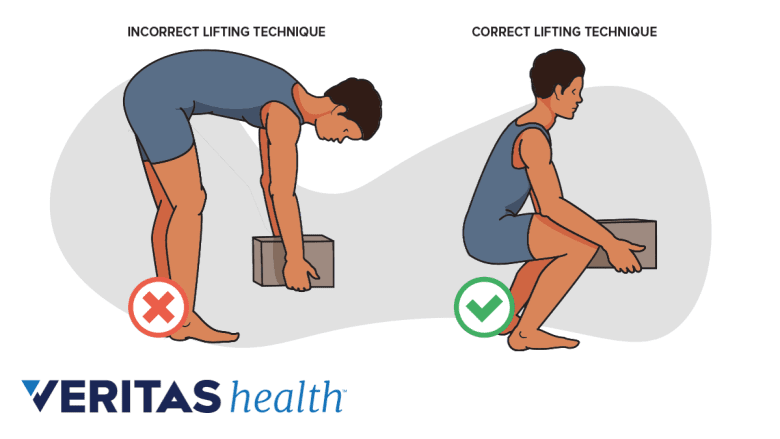By 6 weeks after lumbar microdiscectomy surgery, many patients have returned to most of their regular activities, such as driving, household chores, and light amounts of outdoor work.
A physical therapy program may be advised at this point to help improve the back’s strength and flexibility.
In This Article:
- Postoperative Care for Lumbar Microdiscectomy Surgery
- Lumbar Microdiscectomy Recovery: Discharge to 14 Days
- Lumbar Microdiscectomy Recovery: Weeks 2 to 6
- Lumbar Microdiscectomy Recovery: Weeks 6 to 12
- Pain Management After Microdiscectomy Surgery
Physical Therapy for Improved Strength and Posture
An outpatient physical therapy program may be prescribed about 6 weeks after lumbar microdiscectomy surgery, but many surgeons may start therapy sooner. Key areas of focus may include:
Strengthening

Core strengthening exercises aim to strengthen the muscles in the lower back.
These exercises tend to focus on strengthening the back, abdomen, hips, and other muscles that support the spine. Special exercises may be added to target the lower back and improve function.
See Back Strengthening Exercises After Microdiscectomy Surgery
Stretching
Hamstring stretches promote flexibility and reduce muscle tightness in the lower back and legs.
Gentle stretches are assigned at the start of a physical therapy program and progress over time to help increase the spine’s flexibility. Other treatments to help loosen the soft tissues, such as massage, may also be recommended.
See Stretching Exercise after Microdiscectomy Surgery
Good posture and form

Maintaining a supported posture helps prevent overstretching of lower back muscles.
In addition to ensuring that exercises and stretches are performed correctly and safely, the physical therapist may offer tips for using good posture throughout the day. If the patient is preparing to return to a physical job, safe ways to lift, pull, or push objects may also be taught.
The length of a physical therapy program can depend on the patient’s individual needs. Since a lumbar microdiscectomy leaves much of the spine’s structure and surrounding tissues intact, recovery tends to be faster compared to spinal fusion surgery.
As the patient progresses in physical therapy, he or she may start transitioning to doing more exercises at home and having fewer appointments. After the physical therapy program ends, most patients are advised to continue exercises and stretches at home on a regular basis.
See Return to Exercise After Microdiscectomy Surgery
A Return to Most Activities
Twelve weeks (3 months) after lumbar microdiscectomy, most patients are able to return to almost all activities without restrictions. Returning to heavy lifting and other strenuous activities may take longer.
Physical labor
Before returning to a physically demanding job—such as construction, maintenance, or dance—the patient must demonstrate an ability to perform the required tasks safely. For example, if pain or fatigue are still issues, there is an increased risk for an accident at work. If possible, a gradual return to work may be needed to build up stamina and manage potential flare-ups of pain or stiffness.
Sports
Even though a patient may be mostly pain-free and able to perform routine activities at 6 weeks, a return to athletic competition or contact sports may take longer. Athletic competition may be allowed about 8 to 12 weeks after a microdiscectomy if physical conditioning reaches the necessary level and the sport can be performed without worsening pain.1Cook RW, Hsu WK. Return to play after lumbar spine surgery. Clinics in Sports Medicine. 35(4):609-19. doi: 10.1016/j.csm.2016.05.006 High-impact sports, such as hockey or football, may require a longer recovery period.
Long-Term Outlook
If leg pain resolves or reduces considerably, and overall function improves for daily living, the lumbar microdiscectomy surgery is considered a success.
While there is a risk for another herniation or a second surgery, the benefits of a successful microdiscectomy typically last for many years. One large study found that at an average follow-up of 4 years, about 84% of people who had the surgery rated their results as good or excellent.2Dohrmann GJ, Mansour N. Long-Term Results of Various Operations for Lumbar Disc Herniation: Analysis of over 39,000 Patients. Med Princ Pract. 2015;24(3):285-90. Available from: https://www.ncbi.nlm.nih.gov/pmc/articles/PMC5588202/
See Microdiscectomy Spine Surgery: Risks, Complications, and Success Rates
To maximize the chances of a successful outcome for lumbar microdiscectomy over the long run, it is important to follow the doctor’s directions, get plenty of exercise, and lead an overall healthy lifestyle.
- 1 Cook RW, Hsu WK. Return to play after lumbar spine surgery. Clinics in Sports Medicine. 35(4):609-19. doi: 10.1016/j.csm.2016.05.006
- 2 Dohrmann GJ, Mansour N. Long-Term Results of Various Operations for Lumbar Disc Herniation: Analysis of over 39,000 Patients. Med Princ Pract. 2015;24(3):285-90. Available from: https://www.ncbi.nlm.nih.gov/pmc/articles/PMC5588202/
Editor’s Top Picks
- Back Strengthening Exercises After Microdiscectomy Surgery
- Return to Exercise After Microdiscectomy Surgery
- Stretching Exercise after Microdiscectomy Surgery
- Microdiscectomy (Microdecompression) Spine Surgery
- Lumbar Microdiscectomy Surgery Video
- Microdiscectomy Spine Surgery: Risks, Complications, and Success Rates

